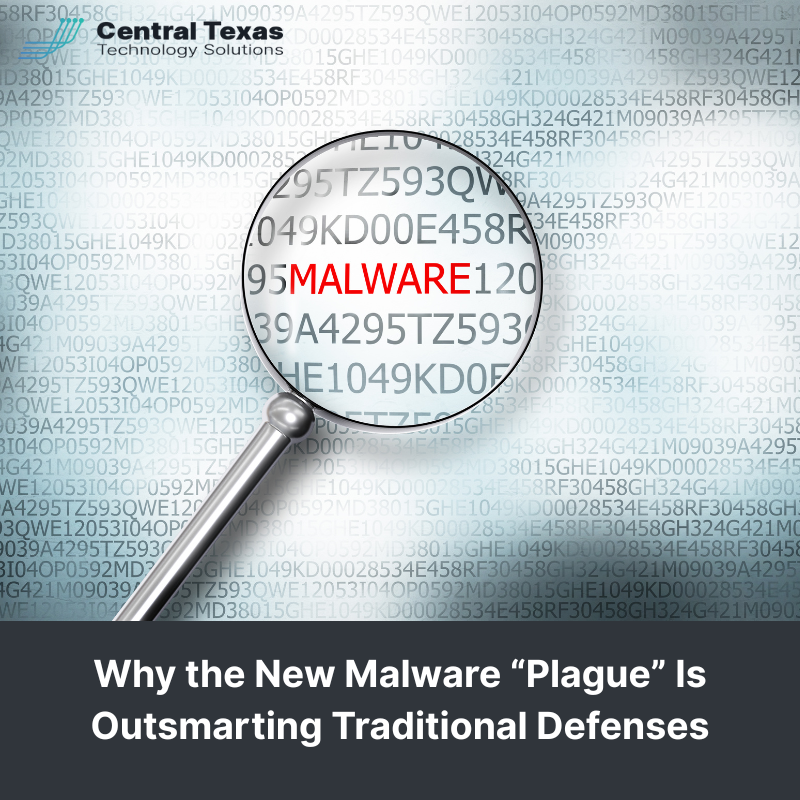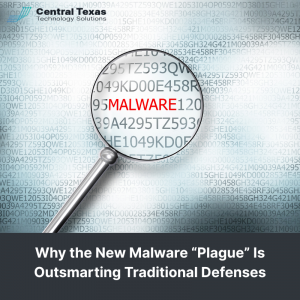
 In today’s cybersecurity landscape, business leaders are facing threats that are more intelligent, patient, and stealthy than ever before. One recent discovery has left even seasoned IT professionals uneasy. Researchers uncovered a Linux-based malware known as Plague that had been operating undetected for more than a year.
In today’s cybersecurity landscape, business leaders are facing threats that are more intelligent, patient, and stealthy than ever before. One recent discovery has left even seasoned IT professionals uneasy. Researchers uncovered a Linux-based malware known as Plague that had been operating undetected for more than a year.
This wasn’t a quick, loud cyberattack. It was a silent infiltration designed to bypass traditional defenses and give attackers persistent access to business systems. For companies that rely on Linux servers to power email, databases, or cloud workloads, the emergence of Plague is a wake-up call.
CTTS helps Austin-area businesses stay ahead of threats like this with layered cybersecurity, active monitoring, and expert-led response planning.
Understanding This New Strain of Malware
The Plague malware is not a typical virus or ransomware attack. It’s a Pluggable Authentication Module (PAM) backdoor, which means it hides in the very core of your system’s authentication process. By embedding itself in this critical layer, it allows hackers to log in through Secure Shell (SSH) without raising alarms.
In essence, Plague turns your security measures against you. It blends into normal system activity and manipulates files and configurations to appear legitimate. Due to its sophisticated design, it can operate undetected, giving attackers months or even years of free access before detection.
How the Plague Malware Stays Hidden
Traditional antivirus tools and firewalls are often powerless against this type of intrusion. Plague uses advanced malware obfuscation techniques to stay invisible:
- Altering system environments so abnormal activity looks normal
- Using static credentials that mimic authorized users
- Manipulating configuration files to hide signs of tampering
Unlike a smash-and-grab attack, Plague takes the long-game approach. Once it’s embedded, attackers can move freely through your network, collecting data, launching additional malware, or quietly preparing for a larger-scale breach.
Why Every Business Should Be Concerned
Some business leaders assume malware like this only targets large enterprises or government networks. In reality, small and midsize businesses are often the preferred victims. Hackers know smaller organizations may lack the same depth of security monitoring or in-house expertise.
Linux systems are widely used across various industries, including Healthcare, Legal, Professional Services, Construction, Manufacturing, and Nonprofits, due to their reliability. That makes them especially attractive targets for long-term infiltration.
Even if you already have strong security tools, Plague can evade detection by hiding behind legitimate processes. Without proactive monitoring, your business could become a silent host for malware activity.
Warning Signs of a Malware Infection
Plague was designed to be stealthy, but certain symptoms can signal a deeper problem. If you notice any of the following, your network may already be compromised:
- SSH logins from unfamiliar locations or odd hours
- Unexplained modifications to PAM or authentication configurations
- Inconsistent system logs or gaps in your activity history
Left unchecked, this backdoor can allow attackers to:
- Move laterally across your network
- Steal sensitive data
- Install additional malware payloads
- Use your systems to launch attacks on other organizations
How to Stay Ahead of Modern Malware Threats
The best defense against Plague and similar malware is a layered, proactive security strategy. Businesses can reduce their risk by:
- Reviewing PAM configurations and SSH access logs regularly
- Deploying advanced monitoring tools that detect unusual behavior, not just known malware signatures
- Applying patches promptly and limiting privileged access
- Training IT teams to recognize the latest malware tactics and stay ahead of evolving threats
Cybercriminals continue to evolve. So must your defenses.
CTTS Helps You Detect and Defend Against Malware
At CTTS, we understand how rapidly threats evolve and how costly it can be to miss an alert. Our cybersecurity services combine advanced detection tools with expert oversight to keep your business one step ahead of emerging threats like Plague.
We partner with organizations across Central Texas to secure their networks, train their teams, and implement security best practices that go beyond basic antivirus protection. With CTTS, you gain peace of mind knowing your systems are monitored, your defenses are modern, and your business is protected.
If you’re unsure whether your Linux servers or network could be at risk, schedule a cybersecurity assessment with CTTS today. Together, we’ll help you uncover hidden vulnerabilities and strengthen your defenses before the next threat strikes.
Frequently Asked Questions
1. What makes the Plague malware different from traditional viruses?
Plague is a PAM backdoor, meaning it integrates directly into the system’s authentication process rather than relying on typical executable files. This allows it to bypass most traditional malware scanners and stay hidden much longer.
2. Can small and midsize businesses really be targeted by this malware?
Yes. Cybercriminals often target smaller organizations because they may lack dedicated security teams or advanced monitoring. Even one compromised Linux server can expose sensitive data and disrupt operations.
3. How can CTTS help protect my business from malware?
CTTS provides layered security solutions, real-time monitoring, vulnerability assessments, and employee training. We help Austin-area businesses proactively identify risks, strengthen defenses, and respond quickly if suspicious activity is detected.
Contact CTTS today for IT support and managed services in Austin, TX. Let us handle your IT so you can focus on growing your business. Visit CTTSonline.com or call us at (512) 388-5559 to get started!
